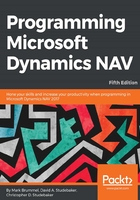
Tables
"If you don't know where you are going, you might wind up someplace else."
- Yogi Berra "Successful design is anticipating the anticipations of others."
- John Maynard Keynes
The foundation of any system is the data structure definition. In NAV, the building blocks of this foundation are the tables and the indpidual data fields that the tables contain. Once the functional analysis and process definition has been completed, any new design work must begin with the data structure. For NAV, that means the tables and their contents.
A NAV table includes much more than just the data fields and keys. A NAV table definition also includes data validation rules, processing rules, business rules, and logic to ensure referential integrity. The rules are in the form of properties and C/AL code.
For object-oriented developers, a Dynamics NAV table is best compared to a class with methods and properties stored one-to-one as a table on SQL Server.
In this chapter, we will learn about the structure and creation of tables. Details regarding fields and the components of tables will be covered in the following chapter. Our topics in this chapter include the following:
- An overview of tables, including Properties, Triggers, Keys, SumIndexFields, and Field Groups
- Enhancing our scenario application - creating and modifying tables
- Types of table - Fully Modifiable, Content Modifiable, and Read-Only tables